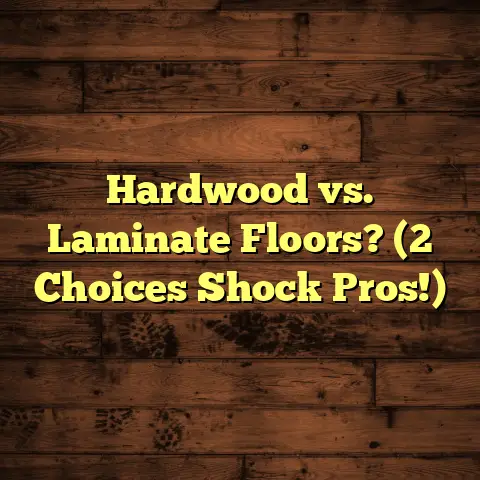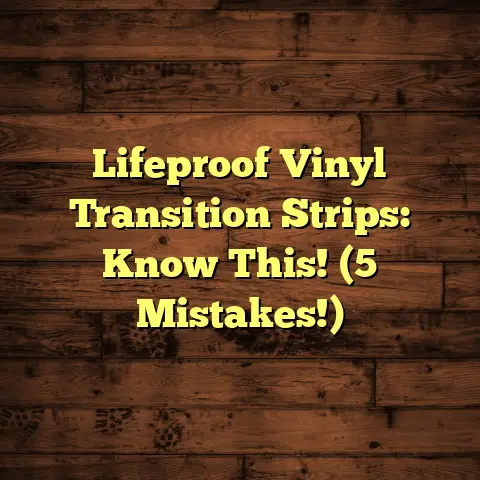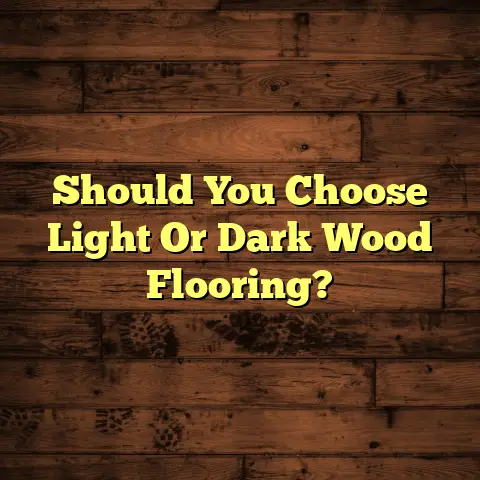LVP Floors Toxic? (7 Safety Concerns Exposed!)
You know, LVP (Luxury Vinyl Plank) flooring is everywhere these days.
It’s the darling of home renovation shows, the go-to for DIYers, and the favorite of interior designers.
Why?
Because it looks great, it’s tough as nails, and it’s often touted as a “green” alternative to hardwood.
But hold on a minute.
Is LVP really as safe and eco-friendly as everyone claims?
That’s what I want to dig into today.
While LVP boasts impressive aesthetics and practicality, there are some serious safety concerns about its toxicity that you need to know.
Let’s pull back the curtain and expose the truth about LVP flooring.
Section 1: What is LVP Flooring?
Okay, let’s start with the basics. What is LVP flooring, exactly?
LVP is a synthetic flooring made primarily from polyvinyl chloride (PVC).
It’s designed to mimic the look of natural materials like wood or stone.
The manufacturing process usually involves several layers:
- Wear Layer: This is the top layer, a clear coating that protects the floor from scratches and wear.
- Decorative Layer: This is a printed image that gives the LVP its wood or stone look.
- Core Layer: This is the main body of the plank, usually made of PVC vinyl.
- Backing Layer: This is the bottom layer, providing stability and sometimes a moisture barrier.
LVP is used everywhere, from homes and apartments to offices and retail spaces.
It’s popular because it’s durable, waterproof, and easy to install.
Plus, it’s typically more affordable than hardwood or tile.
I’ve seen LVP transform countless spaces, and its popularity has exploded over the last decade.
The demand for synthetic flooring options keeps growing as people seek cost-effective and low-maintenance solutions.
A Brief History
LVP has evolved quite a bit.
Vinyl flooring has been around since the early 20th century, but LVP as we know it today really took off in the 2000s.
Early versions weren’t as realistic or durable, but advancements in printing and manufacturing have made LVP a serious contender in the flooring market.
Advantages of LVP Flooring
Let’s be fair, LVP has some great qualities:
- Durability: It can withstand heavy foot traffic and resist scratches and dents.
- Water Resistance: Perfect for kitchens, bathrooms, and basements.
- Ease of Installation: Many LVP products are designed for DIY installation with click-lock systems.
- Cost-Effective: Generally cheaper than hardwood, tile, or stone.
- Aesthetic Versatility: Available in a wide range of styles and colors to match any décor.
Section 2: Safety Concern #1 – Chemical Composition
Okay, now for the not-so-pretty part.
What’s actually in LVP flooring?
This is where things get a little concerning.
LVP contains a cocktail of chemicals, and some of them aren’t exactly good for you.
Here are some of the most common culprits:
- Phthalates: These are plasticizers used to make the vinyl flexible.
Some phthalates have been linked to hormone disruption and reproductive issues. - Formaldehyde: This is a known carcinogen that can be used in the adhesives or coatings of LVP.
- Volatile Organic Compounds (VOCs): These are chemicals that evaporate at room temperature, releasing fumes into the air.
VOCs can cause a range of health problems, from headaches and nausea to respiratory irritation and even cancer.
These chemicals are used in the production of LVP to achieve certain properties like flexibility, durability, and water resistance.
However, they can also leach out of the flooring over time, especially when exposed to heat or sunlight.
Potential Health Effects
The health effects of these chemicals can vary depending on the level of exposure and individual sensitivity.
Some common symptoms include:
- Headaches
- Nausea
- Dizziness
- Eye, nose, and throat irritation
- Respiratory problems
- Allergic reactions
Scientific Studies and Expert Opinions
The science on the health effects of LVP is still evolving, but there are definitely reasons to be concerned.
For example, a study by the Environmental Protection Agency (EPA) found that some vinyl flooring products can release significant levels of VOCs.
Experts like Dr. Philip Landrigan, a pediatrician and environmental health expert, have warned about the potential health risks of phthalates and other chemicals found in vinyl flooring.
Section 3: Safety Concern #2 – Off-Gassing
Let’s dive deeper into off-gassing.
What is it, and why should you care?
Off-gassing is the release of VOCs and other chemicals from a material into the air.
It’s like when you buy a new car and it has that “new car smell.”
That smell is actually a bunch of chemicals off-gassing from the plastic, upholstery, and other materials.
LVP flooring also off-gasses, especially when it’s new.
The fumes released can contain a variety of chemicals, including those mentioned earlier: phthalates, formaldehyde, and other VOCs.
Short-Term and Long-Term Health Effects
The health effects of off-gassing can be both short-term and long-term.
- Short-Term: Headaches, nausea, dizziness, eye/nose/throat irritation.
- Long-Term: Respiratory issues, allergic reactions, potential increased cancer risk.
Sensitive populations, like children, the elderly, and people with asthma or allergies, are particularly vulnerable to the effects of off-gassing.
Personal Experience
I had a client a few years back, Sarah, who installed LVP throughout her entire house.
Within a few weeks, she started experiencing headaches, fatigue, and a persistent cough.
Her doctor couldn’t find anything wrong, but Sarah suspected the new flooring.
After some research and testing, it turned out that her LVP was off-gassing high levels of VOCs.
She ended up having to replace the flooring, and her symptoms gradually improved.
Stories like Sarah’s are a stark reminder of the potential health risks of LVP.
Section 4: Safety Concern #3 – Environmental Impact
Okay, let’s shift our focus to the environmental side of things.
How does LVP flooring impact the planet?
While LVP is often marketed as a “sustainable” alternative to hardwood, the truth is a bit more complicated.
Resource Extraction and Manufacturing Emissions
The production of LVP involves the extraction of raw materials like petroleum and chlorine.
These materials are used to make PVC, the main component of LVP.
The manufacturing process can also generate significant emissions of greenhouse gases and other pollutants.
End-of-Life Disposal
One of the biggest environmental challenges with LVP is what happens when it’s time to replace it.
LVP is not biodegradable, meaning it won’t break down naturally in a landfill.
It can take hundreds of years for LVP to decompose, if it ever does.
Recycling LVP is also difficult and not widely available.
Most LVP ends up in landfills, where it can leach chemicals into the soil and water.
The Sustainability Paradox
While LVP may seem like a greener choice than hardwood (which requires cutting down trees), its environmental footprint is actually quite significant.
The extraction of raw materials, manufacturing emissions, and end-of-life disposal all contribute to its environmental impact.
Section 5: Safety Concern #4 – Indoor Air Quality
Let’s talk about the air you breathe.
How does LVP flooring affect the air quality inside your home?
As we’ve already discussed, LVP can off-gas VOCs and other chemicals into the air.
These pollutants can accumulate indoors, especially in poorly ventilated spaces.
Studies Linking LVP to Indoor Air Pollution
Several studies have linked the presence of LVP flooring to increased levels of indoor air pollutants.
For example, a study by the California Department of Public Health found that vinyl flooring can contribute to elevated levels of VOCs in indoor air.
These pollutants can trigger a range of health problems, from respiratory irritation and allergies to more serious conditions like asthma and cancer.
Maintaining Healthy Indoor Air Quality
If you have LVP flooring, or if you’re considering installing it, there are steps you can take to improve your indoor air quality:
- Ventilation: Open windows and doors regularly to circulate fresh air.
- Air Purifiers: Use air purifiers with HEPA filters to remove pollutants from the air.
- Low-VOC Products: Choose LVP products that are certified as low-VOC.
- Proper Installation: Follow the manufacturer’s instructions carefully to minimize off-gassing.
Section 6: Safety Concern #5 – Allergens and Microbial Growth
Beyond chemicals, LVP can also affect your health in other ways.
Let’s talk about allergens and microbial growth.
LVP is often marketed as being hypoallergenic and resistant to mold and mildew.
And, in some ways, that’s true.
LVP doesn’t provide a food source for mold like natural materials such as hardwood or carpet.
However, LVP can still harbor allergens, dust mites, and other pathogens.
Allergens and Dust Mites
The textured surface of LVP can trap dust, pollen, and other allergens.
Dust mites, which are a common cause of allergies, can also thrive in LVP flooring, especially if it’s not cleaned regularly.
Microbial Growth
While LVP is water-resistant, it’s not completely waterproof.
If moisture gets trapped underneath the flooring, it can create a breeding ground for mold and mildew.
This is especially true in areas with high humidity or where spills are common.
Cleanliness and Maintenance
Regular cleaning is essential to prevent the buildup of allergens and microbial growth on LVP flooring.
Vacuum regularly, and mop with a mild detergent and water.
Be sure to dry the floor thoroughly after mopping to prevent moisture from getting trapped underneath.
Section 7: Safety Concern #6 – Misleading Marketing Claims
Let’s talk about marketing.
How are LVP manufacturers portraying their products, and are they being completely honest?
Unfortunately, some LVP manufacturers may downplay or omit potential health risks in their marketing materials.
They may focus on the benefits of LVP (durability, water resistance, affordability) while minimizing the potential downsides (chemical emissions, environmental impact).
Certifications and Labels
Many LVP products come with certifications and labels that claim to ensure safety.
These labels can include:
- FloorScore: This certification indicates that the product meets certain VOC emission standards.
- GreenGuard: This certification also indicates that the product meets certain VOC emission standards.
- Phthalate-Free: This label indicates that the product does not contain phthalates.
However, it’s important to note that these certifications are not always foolproof.
Some certifications may have less stringent standards than others, and some manufacturers may not accurately test their products.
Consumer Awareness
As a consumer, it’s important to be aware of the potential for misleading marketing claims.
Do your research, read reviews, and ask questions before you buy.
Don’t rely solely on the information provided by the manufacturer.
Section 8: Safety Concern #7 – Regulatory Oversight
Finally, let’s talk about regulations.
Who’s watching over the LVP industry to ensure that products are safe?
The regulatory landscape governing the production and sale of LVP flooring varies depending on the region.
In the United States, the Environmental Protection Agency (EPA) sets some standards for VOC emissions from flooring products.
However, there are gaps in regulation that allow potentially harmful products to enter the market.
Regulatory Gaps
For example, there are no federal regulations that specifically limit the amount of phthalates that can be used in LVP flooring.
This means that manufacturers can use phthalates in their products without violating any federal laws.
Advocacy Efforts
There are ongoing advocacy efforts aimed at improving safety standards for flooring materials.
Environmental and consumer advocacy groups are working to push for stricter regulations on VOC emissions, phthalates, and other harmful chemicals.
The Importance of Regulation
Strong regulatory oversight is essential to protect consumers from the potential health risks of LVP flooring.
Without adequate regulation, manufacturers may be tempted to cut corners and use cheaper, more harmful materials.
Conclusion
Okay, we’ve covered a lot of ground today.
Let’s recap the key safety concerns associated with LVP flooring:
- Chemical Composition: LVP contains potentially harmful chemicals like phthalates, formaldehyde, and VOCs.
- Off-Gassing: LVP can release these chemicals into the air, causing health problems.
- Environmental Impact: The production and disposal of LVP have significant environmental consequences.
- Indoor Air Quality: LVP can contribute to poor indoor air quality.
- Allergens and Microbial Growth: LVP can harbor allergens and support microbial growth.
- Misleading Marketing Claims: LVP manufacturers may downplay potential health risks.
- Regulatory Oversight: There are gaps in regulation that allow potentially harmful products to enter the market.
Consumer Awareness
I hope this article has shed some light on the potential toxicity of LVP flooring.
It’s important to be aware of these factors when choosing flooring for your home.
Call to Action
I encourage you to do further research and advocate for safer flooring options in the industry.
Together, we can create a healthier and more sustainable future.
Thanks for reading, and happy flooring!





